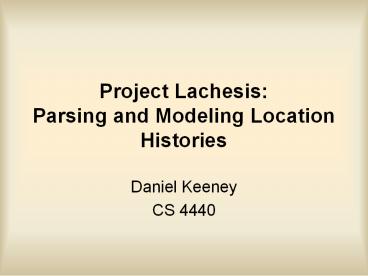Project Lachesis: Parsing and Modeling Location Histories - PowerPoint PPT Presentation
Title:
Project Lachesis: Parsing and Modeling Location Histories
Description:
Destination is any place where one or more objects have experienced a stay ... The stay duration, is how long an object must remain within the roaming distance ... – PowerPoint PPT presentation
Number of Views:153
Avg rating:3.0/5.0
Title: Project Lachesis: Parsing and Modeling Location Histories
1
Project LachesisParsing and Modeling Location
Histories
- Daniel Keeney
- CS 4440
2
Introduction
- Location History is a record of an entitys
location in geographical space over time - Archaeologists and historians look at migrations
and census data to reconstruct location histories - New technologies such as GPS allow us to enhance
the accuracy and resolution greatly
3
Resolution
- Old temporal resolutions ranged from a decade to
a century - Old spatial resolutions ranged from tens to
hundreds of kilometers - GPS accuracy opens up a completely different type
of analysis
4
Goal
- By tracking locations in real time, new types of
analysis can be performed - Goal condense, understand, and predict the
movements of an object over a period of time
5
Stays and Destinations
- Stay is a single instance of an object spending
some time in one place - Destination is any place where one or more
objects have experienced a stay - Trip occurs between two adjacent stays made by
the same object - Path is a representation of the description of a
set of trips between destinations
6
Calculating Stays
- The roaming distance, is how far an object
can stray while being counted as a stay - The stay duration, is how long an object
must remain within the roaming distance to count
as a stay - Medoid is the data point nearest to the center
of the set
7
Calculating Stays
8
Calculating Stays
- Worst case O(n2) for n data points, due to
medoid and diameter working on all pairs - In practice, clusters which require computation
are far smaller than n, effectively yielding O(n)
9
Calculating Destinations
- Geographic scale, determines how close two
stays can be and still be considered the same
destination - Destinations are represented by a location as
well as the scale used
10
Calculating Destinations
11
Example
12
(No Transcript)
13
(No Transcript)
14
(No Transcript)
15
Creating Probabilistic Models
- Assumptions
- At the beginning of a given time interval, an
object is at exactly one destination - During any given time interval, an object makes
exactly one transition between destinations - Self-transitions are allowed
16
Creating Probabilistic Models
- Models are similar to Hidden Markov Models
- Critical difference from HMM is the incorporation
of time-dependence, where transition
probabilities are conditioned on recurring time
intervals
17
Creating Probabilistic Models
- Model consists of three probability matrices
- Probability of the object starting time interval
at destination is - Probability of transition from to during
interval is - Observation probability observing
object at when actually at
18
Calculating p
19
Calculating A
20
Calculating B
21
Calculating Probabilistic Models
- Together as these tables represent
a probabilistic model - This model can be used to solve problems such as
finding the most likely destination occupied at a
particular time, determining the relative
likelihood of a location history sequence, or
generating a location history sequence
22
Calculating Probabilistic Models
- Using ? we estimate the relative likelihood of a
new location history - This is done using a Non-Markovian Solution and a
Markovian Solution
23
Non-Markovian Solution
24
Markovian Solution
25
Experiment Results
26
Experiment Results
27
Experiment Results
28
Experiment Results
I always felt more productive on Tuesdays. -
Subject A
29
Experiment Results
30
Experiment Results
A typical (left) and an atypical (right) week
from Subject A.
31
Experimental Results
Plots of synthesized weeks, using Non-Markov
(left) and Markov (right) models
32
Markov vs. Non-Markov
- Markovian model showed an atypical week to have
an unexpectedly high probability - This could be mitigated by training on larger
data sets, but generally the Non-Markovian model
is sufficient
33
Conclusions
- Proposed rigorous definitions for location
histories, stays, and destinations, as well as
accompanying algorithms - Non-Markovian is better suited for evaluating
likelihoods of a location history - Markovian is better for stochastically generating
a history - Future papers will examine trips and paths































